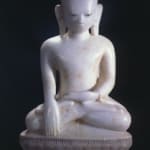Marble Sculpture of the Buddha, 18th Century CE - 19th Century CE
Marble
H.029
Seated in dhyanasana on an oblong throne with incised lotus border, the Buddha clasps his hands in bhumisparsa and dhyana mudras. The delicate features of his oval face consist of...
Seated in dhyanasana on an oblong throne with incised lotus border, the Buddha clasps his hands in bhumisparsa and dhyana mudras. The delicate features of his oval face consist of a wide forehead, narrow downcast eyes outlined in black lacquer, small nose and smiling mouth all situated between elongated earlobes touching the ridge of his neck and shoulder line. The hair forms a definitive line, gently covering the rise of the ushnisa surmounted by a bud-shaped finial. The appearance of clothing is obfuscated by the body's fluid lines, however the Buddha's transparent garments surface on one side, evidenced through the incised markings on the chest and folds on the arm.
Adoration of the Buddha was often expressed through the production of stone statuary. Devout worshippers touched the divine images, asking for the Buddha's protection and mercy in prayer.
The Shan have inhabited the Shan Plateau and other parts of modern-day Myanmar as far back as the 1200s. They are believed to have migrated from the mountains of Yunnan in China. The Shan are descendants of the oldest branch of the Tai ethnicity, known as Tai Long (Great Tai). Shan who migrated to the south and now inhabit modern-day Laos and Thailand are known as Tai Noi (or Tai Nyai), while those in parts of northern Thailand and Laos are commonly known as Tai Noi (Little Tai - Lao spoken).
Adoration of the Buddha was often expressed through the production of stone statuary. Devout worshippers touched the divine images, asking for the Buddha's protection and mercy in prayer.
The Shan have inhabited the Shan Plateau and other parts of modern-day Myanmar as far back as the 1200s. They are believed to have migrated from the mountains of Yunnan in China. The Shan are descendants of the oldest branch of the Tai ethnicity, known as Tai Long (Great Tai). Shan who migrated to the south and now inhabit modern-day Laos and Thailand are known as Tai Noi (or Tai Nyai), while those in parts of northern Thailand and Laos are commonly known as Tai Noi (Little Tai - Lao spoken).



